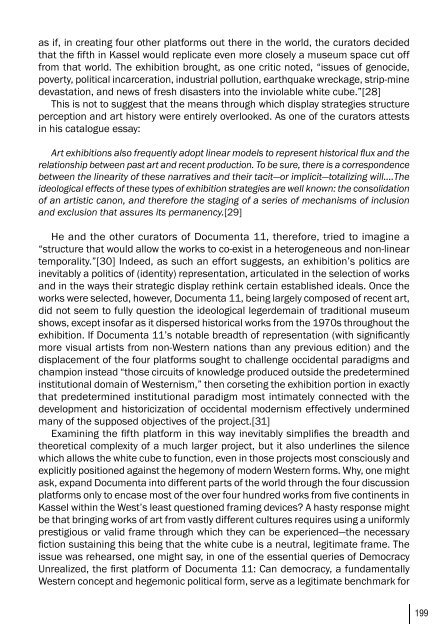art-e-conomy _ reader - marko stamenkovic
art-e-conomy _ reader - marko stamenkovic
art-e-conomy _ reader - marko stamenkovic
Create successful ePaper yourself
Turn your PDF publications into a flip-book with our unique Google optimized e-Paper software.
as if, in creating four other platforms out there in the world, the curators decided<br />
that the fifth in Kassel would replicate even more closely a museum space cut off<br />
from that world. The exhibition brought, as one critic noted, “issues of genocide,<br />
poverty, political incarceration, industrial pollution, e<strong>art</strong>hquake wreckage, strip-mine<br />
devastation, and news of fresh disasters into the inviolable white cube.”[28]<br />
This is not to suggest that the means through which display strategies structure<br />
perception and <strong>art</strong> history were entirely overlooked. As one of the curators attests<br />
in his catalogue essay:<br />
Art exhibitions also frequently adopt linear models to represent historical flux and the<br />
relationship between past <strong>art</strong> and recent production. To be sure, there is a correspondence<br />
between the linearity of these narratives and their tacit—or implicit—totalizing will….The<br />
ideological effects of these types of exhibition strategies are well known: the consolidation<br />
of an <strong>art</strong>istic canon, and therefore the staging of a series of mechanisms of inclusion<br />
and exclusion that assures its permanency.[29]<br />
He and the other curators of Documenta 11, therefore, tried to imagine a<br />
“structure that would allow the works to co-exist in a heterogeneous and non-linear<br />
temporality.”[30] Indeed, as such an effort suggests, an exhibition’s politics are<br />
inevitably a politics of (identity) representation, <strong>art</strong>iculated in the selection of works<br />
and in the ways their strategic display rethink certain established ideals. Once the<br />
works were selected, however, Documenta 11, being largely composed of recent <strong>art</strong>,<br />
did not seem to fully question the ideological legerdemain of traditional museum<br />
shows, except insofar as it dispersed historical works from the 1970s throughout the<br />
exhibition. If Documenta 11’s notable breadth of representation (with significantly<br />
more visual <strong>art</strong>ists from non-Western nations than any previous edition) and the<br />
displacement of the four platforms sought to challenge occidental paradigms and<br />
champion instead “those circuits of knowledge produced outside the predetermined<br />
institutional domain of Westernism,” then corseting the exhibition portion in exactly<br />
that predetermined institutional paradigm most intimately connected with the<br />
development and historicization of occidental modernism effectively undermined<br />
many of the supposed objectives of the project.[31]<br />
Examining the fifth platform in this way inevitably simplifies the breadth and<br />
theoretical complexity of a much larger project, but it also underlines the silence<br />
which allows the white cube to function, even in those projects most consciously and<br />
explicitly positioned against the hegemony of modern Western forms. Why, one might<br />
ask, expand Documenta into different p<strong>art</strong>s of the world through the four discussion<br />
platforms only to encase most of the over four hundred works from five continents in<br />
Kassel within the West’s least questioned framing devices? A hasty response might<br />
be that bringing works of <strong>art</strong> from vastly different cultures requires using a uniformly<br />
prestigious or valid frame through which they can be experienced—the necessary<br />
fiction sustaining this being that the white cube is a neutral, legitimate frame. The<br />
issue was rehearsed, one might say, in one of the essential queries of Democracy<br />
Unrealized, the first platform of Documenta 11: Can democracy, a fundamentally<br />
Western concept and hegemonic political form, serve as a legitimate benchmark for<br />
199


